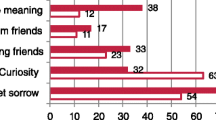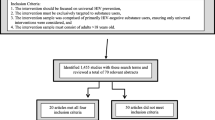Abstract
A community-based HIV intervention for African-American women who are active injection drug users (IDUs) was evaluated. Seventy-one women (aged 20–54 years) were randomly assigned to one of two enhanced gender- and culturally specific intervention conditions or to the NIDA standard condition. Substantial decreases (p < .001) were found in the frequency of drug use and the frequency of drug injection as well as in the sharing of injection works or water and the number of injections. Trading sex for drugs or money, having sex while high, as well as other sexual risk behaviors were also reduced significantly. Furthermore, women in both enhanced intervention conditions were more likely to reduce their drug-using and sexual risk behaviors than were women in the standard condition. Results indicate the value of including additional components in interventions designed to reduce the risk of infection with HIV among women who inject drugs.
Similar content being viewed by others
References
Adair, E. B., Craddock, S. G., Miller, H. G., and Turner, C. F. (1996). Quality of treatment data. Reliability over time of self-reports given by clients in treatment for substance abuse. Journal of Substance Abuse Treatment, 13, 145-149.
Airhihenbuwa, C. O., DiClemente, R. J., Wingood, G. M., and Lowe, A. (1992). HIV/AIDS education and prevention among African-Americans: A focus on culture. AIDS Education and Prevention, 4, 267-276.
Ajzen, I., and Madden, T. J. (1986). Prediction of goal-directed behavior: Attitudes, intentions, and perceived behavioral control. Journal of Experimental Social Psychology, 22, 453-474.
Amaro, H. (1995). Love, sex, and power: Considering women's realities in HIV prevention. American Psychologist, 50, 437-447.
Anglin, M. D., Hser, Y. I., and McGlothlin, W. H. (1987). Sex differences in addict careers. 2. Becoming addicted. American Journal of Drug and Alcohol Abuse, 13, 59-71.
Bandura, A. (1977). Self-efficacy. Psychological Review, 84, 191-215.
Battjes, R. J., Pickens, R. W., Haverkos, H. W., and Sloboda, Z. (1994). HIV risk factors among injecting drug users in five U.S. cities. AIDS, 8, 681-687.
Booth, R. E., Kwiatkowski, C. F., and Stephens, R. C. (1998). Effectiveness of HIV/AIDS interventions on drug use and needle risk behaviors for out-of-treatment injection drug users. Journal of Psychoactive Drugs, 30, 269-278.
Booth, R. E., Kwiatkowski, C. F., and Chitwood, D. D. (2000). Sex related HIV risk behaviors: Differential risks among injection drug users, crack smokers, and injection drug users who smoke crack. Drug and Alcohol Dependence, 58, 219-226.
Boyd, C. J. (1993). The antecedents of women's crack cocaine abuse: Family substance abuse, sexual abuse, depression and illicit drug use. Journal of Substance Abuse Treatment, 10, 433-438.
Carey, M. P. (1999). Motivational strategies can enhance HIV risk reduction programs. AIDS and Behavior, 3, 269-276.
Centers for Disease Control and Prevention. (2001). HIV/AIDS surveillance in women. Available at http://www.cdc.gov/hiv/graphics/women.htm; accessed September 27, 2001.
Clements, K., Gleghorn, A., Garcia, D., Katz, M., and Marx, R. (1997). A risk profile of street youth in northern California: Implications for gender-specific human immunodeficiency virus prevention. Journal of Adolescent Health, 20, 343-353.
Cohen, J. (1988). Statistical power analysis for the behavioral sciences (2nd ed.). Hillsdale, NJ: Erlbaum.
Connell, R. W. (1985). Theorising gender. Sociology, 19, 260-272.
Cottler, L. B., Leukefeld, C., Hoffman, J., Desmond, D., Wechsberg, W., Inciardi, J. A., Compton, W. M., Ben Abdallah, A., Cunningham-Williams, R., and Woodson, S. (1998). Effectiveness of HIV risk reduction initiatives among out-of-treatment non-injection drug users. Journal of Psychoactive Drugs, 30, 279-290.
Coyle, S. L. (1998). Women's drug use and HIV risk: Findings from NIDA's cooperative agreement for community-based outreach/intervention research program. Women and Health, 27, 1-18.
Dekin, B. (1996). Gender differences in HIV-related self-reported knowledge, attitudes, and behaviors among college students. American Journal of Preventive Medicine, 12, 61-66.
Deren, S., Davis, R., Tortu, S., Beardsley, M., I. Ahluwalia, and National AIDS Research Consortium. (1995). Women at high-risk for HIV: Pregnancy and risk behaviors. Journal of Drug Issues, 25, 57-71.
Des Jarlais, D. C., Friedman, S. R., Perlis, T., Chapman, T. F., Sotheran, J. L., Paone, D., Monterroso, E., and Neaigus, A. (1999). Risk behavior and HIV infection among new drug injectors in the era of AIDS in New York City. Journal of Acquired Immune Deficiency Syndromes, 20, 67-72.
DiClemente, R. J., and Wingood, G. M. (1995). A randomized controlled trial of an HIV sexual risk-reduction intervention for young African-American women. Journal of the American Medical Association, 274, 1271-1276.
Dowling-Guyer, S., Johnson, M. E., Fisher, D. G., and Needle, R. (1994). Reliability of drug users' self-reported HIV risk behaviors and validity of self-reported recent drug use. Assessment, 1, 383-392.
Ehrhardt, A. A., and Exner, T. M. (2000). Prevention of sexual risk behavior for HIV infection with women. AIDS, 14, S53-S58.
el-Bassel, N., and Schilling, R. F. (1992). 15-month follow-up of women methadone patients taught skills to reduce heterosexual HIV transmission. Public Health Reports, 107, 500-504.
Elifson, K. W., and Sterk, C. E. (2003). Case study: The health intervention project. In D. Blumenthal and R. DiClemente (Eds.), Community-based research: Issues and methods. New York, Springer.
Fishbein, M., and Middlestadt, S. E. (1989). Using the theory of reasoned action as a framework for understanding and changing AIDS-related behaviors. In J. N. Wasserheit (Ed.), Primary prevention of AIDS: Psychological approaches (pp. 93-110). Thousand Oaks, CA: Sage.
Freeman, R. C., Williams, M. L., and Saunders, L. A. (1999). Drug use, AIDS knowledge, and HIV risk behaviors of Cuban-, Mexican-, and Puerto-Rican-born drug injectors who are recent entrants into the United States. Substance Use and Misuse, 34, 1765-1793.
Garfein, R. S., Vlahov, D., Galai, N., Doherty, M. C., and Nelson, K. E. (1996). Viral infections in short-term injection drug users: The prevalence of the hepatitis C, hepatitis B, human immunodeficiency, and human T-lymphotropic viruses. American Journal of Public Health, 86, 655-661.
Ickovics, J. R., and Yoshikawa, H. (1998). Preventive interventions to reduce heterosexual HIV risk for women: Current perspectives, future directions. AIDS, 12, S197-S208.
Institute of Medicine, National Academy of Sciences. (1995). Assessing the social and behavioral science base for HIV/AIDS prevention and intervention: Workshop summary. Washington, DC: National Academy Press.
Jemmott, L. S., and Jemmott, J. B. (1992). Increasing condom-use intentions among sexually active Black adolescent women. Nursing Research, 41, 273-279.
Kane, S. (1991). HIV, heroin and heterosexual relations. Social Science and Medicine, 32, 1037-1050.
Kelly, J. A. (1994). Sexually transmitted disease prevention approaches that work. Interventions to reduce risk behavior among individuals, groups, and communities. Sexually Transmitted Diseases, 21, S73-S75.
Makulowich, G. S. (1997). Certain social and cultural factors put women at risk of HIV infection. AIDS Patient Care and STDs, 11, 201.
Mays, V., and Cochran, S. (1988). Interpretation of AIDS risk and risk reduction activities by Black and Hispanic women. American Pyschologist, 43, 949-957.
Miller, M., and Neaigus, A. (2001). Networks, resources and risk among women who use drugs. Social Science and Medicine, 52, 967-978.
Morrison-Beedy, D., Carey, M. P., Lewis, B. P., and Aronowitz, T. (2001). HIV risk behavior and psychological correlates among Native American women: An exploratory investigation. Journal of Women's Health and Gender-Based Medicine, 10, 487-494.
National Institute on Drug Abuse. (1992). The standard intervention of the cooperative agreement program for AIDS community-based outreach/intervention research. Cooperative Agreement Steering Committee, January 9–10, 1992.
Needle, R., Fisher, D. G.,Weatherby, N., Chitwood, D., Brown, B., Cesari, H., Booth, R., Williams, M. L., Watters, J., Andersen, M. and Braunstein, M. (1995). Reliability of self-reported HIV risk behaviors of drug users. Psychology of Addictive Behaviors, 9, 242-250.
Needle, R., Coyle, S. L., Normand, J., Lambert, E., and Cesari, H. (1998). HIV prevention with drug-using populations–Current status and future prospects: Introduction and overview. Public Health Reports, 113, 4-18.
Newman, P. A., and Zimmerman, M. A. (2000). Gender differences in HIV-related sexual risk behavior among urban African American youth: A multivariate approach. AIDS Education and Prevention, 12, 308-325.
Nyamathi, A. M., Leake, B., Flaskerud, J. H., Lewis, C., and Bennett, C. (1993). Outcomes of specialized and traditional AIDS counseling programs for impoverished women of color. Research in Nursing and Health, 16, 11-21.
O'Leary, A. (1999). Preventing HIV infection in heterosexual women: What do we know? What must we learn? Applied and Preventive Psychology, 8, 257-263.
Prochaska, J., and DiClemente, C. (1983). Stages and processes of self-change of smoking. Journal of Consulting and Clinical Psychology, 51, 390-395.
Rosenbaum, M. (1981). Women on heroin. New Brunswick, NJ: Rutgers University Press.
Singer, M. (1991). Confronting the AIDS epidemic among IV drug users: Does ethnic culture matter? AIDS Education and Prevention, 3, 258-283.
Sloboda, Z. (1998). What we have learned from research about the prevention of HIV transmission among drug abusers? Public Health Reports, 113, 194-204.
Stephens, R., Simpson, S., Coyle, S., et al. (1993). Comparative effectiveness of NADR interventions. In B. Brown and G. Beschner (Eds.), Handbook on risk of AIDS (pp. 519-556). Westport, CT: Greenwood.
Sterk, C. E. (1999). Fast lives: Women who use crack cocaine. Philadelphia: Temple University Press.
Sterk, C. E. (2000). Tricking and tripping: Prostitution in the era of AIDS. Putnam Valley, NY: Social Change Press.
Sterk-Elifson, C. (1993). Outreach among drug users: Combining the role of ethnographic field assistant and health educator. Human Organization, 52, 162-168.
Stevens, S., Tortu, S., and Coyle, S. L. (1998). Women drug users and HIV prevention: Overview of findings and research needs. Women and Health, 27, 19-23.
Strathdee, S. A., Galai, N., Safaiean, M., Celentano, D. D., Vlahov, D., Johnson, L., and Nelson, K. E. (2001). Sex differences in risk factors for HIV seroconversion among injection drug users–A 10-year perspective. Archives of Internal Medicine, 161, 1281-1288.
Tashima, N., Crain, S., O'Reilly, K., and Sterk-Elifson, C. (1996). The community identification process: A discovery model. Qualitative Health Research, 6, 23-48.
Watters, J. K., and Biernacki, P. (1989). Targeted sampling: Options for the study of hidden populations. Social Problems, 36, 416-430.
Wechsberg, W. M., Dennis, M. L., and Stevens, S. J. (1998). Cluster analysis of HIV intervention outcomes among substance-abusing women. American Journal of Drug and Alcohol Abuse, 24, 239-257.
Weeks, M., Schensul, J., Williams, S., Singer, M., and Grier, M. (1995). AIDS prevention for African-American and Latino women. AIDS Education and Prevention, 7, 251-263.
Weinfurt, K. P. (2000). Repeated measures analyses: ANOVA, MANOVA, and HLM. In L. G. Grimm and P. R. Yarnold (Eds.), Reading and understanding more multivariate statistics (pp. 317-361). Washington, DC: American Psychological Association.
Weissman, G., and National AIDS Research Consortium. (1991). AIDS Prevention for women at risk. AIDS Education and Prevention, 12, 49-63.
Werts, C. E., and Linn, L. (1970). A general linear model for studying growth. Psychological Bulletin, 73, 17-22.
Wolfinger, R., and O'Connell, M. (1993). Generalized linear mixed models: A pseudo-likelihood approach. Journal of Statistical Computation and Simulation, 48, 233-244.
Zeiger, S. L., and Liang, K. Y. (1986). Longitudinal data analysis for discrete and continuous outcomes. Biometrics, 42, 121-130.
Author information
Authors and Affiliations
Corresponding author
Rights and permissions
About this article
Cite this article
Sterk, C.E., Theall, K.P., Elifson, K.W. et al. HIV Risk Reduction Among African-American Women Who Inject Drugs: A Randomized Controlled Trial. AIDS Behav 7, 73–86 (2003). https://doi.org/10.1023/A:1022565524508
Issue Date:
DOI: https://doi.org/10.1023/A:1022565524508




